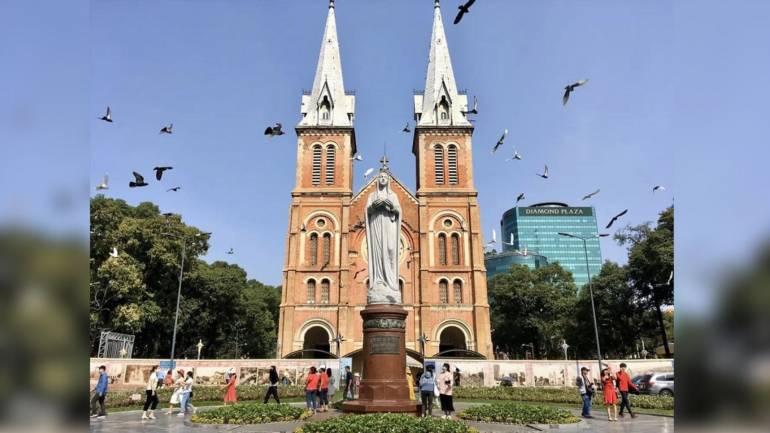Saigon Notre Dame Cathedral: A testament to Vietnamese enduring faith

The cathedral is a testament to the Vietnamese people's dedication to preserving their sacred heritage.
Completed in 1880, the Notre Dame Cathedral in Saigon stands as a striking example of Romanesque architecture, often regarded as the most beautiful cathedral built by the French in their colonies.
The Romanesque style, which blends elements from the Roman and Byzantine Empires, is characterized by thick walls, high round arches, small windows, massive towers, and barrel vaults.
Notre Dame Cathedral embodies these features, creating an imposing and awe-inspiring structure.
Constructed with materials imported from France, the foundation of the cathedral was designed to support ten times its weight, ensuring its durability.
The church itself measures 93 meters in length and 35 meters in width, with a dome rising 21 meters high.
The cathedral’s bright red bricks create a visually stunning exterior, captivating onlookers and inviting them to decode the symbolic meanings behind its colors, shapes, sizes, and patterns.
The two spires, made of iron and reaching towards the sky, harmonize with the clouds, symbolizing righteousness, enlightenment, and simplicity.
These spires, each 60 meters tall, house six power-operated bronze bells whose peals can be heard up to 10 kilometers away.
In front of the cathedral stands a statue of Mary, installed in 1959. Measuring 4.6 meters tall and weighing eight tons, the statue is carved from white granite and adds to the cathedral’s grandeur.
Inside, the cathedral is supported by 12 pillars, representing the 12 apostles. The walls are adorned with circular stained glass windows that depict biblical scenes, allowing light to illuminate the church’s interior.
The altar in the Holy Palace is made of monolithic marble, features six intricately carved angels.
The cathedral can accommodate up to 1,200 people, serving as a significant place of worship and community for the local Catholic population.
The history of Catholicism in Vietnam began in the 16th century with missionaries from Portugal and Spain, although significant progress was made in the 17th century.
The Catholic faith faced severe suppression during the Nguyễn dynasty from 1820 to 1883, but the arrival of the French facilitated its spread.
Following World War II, the French attempted to restore colonial power in Vietnam but were defeated in the First Indo-China War.
The Geneva Accords of 1954 divided Vietnam into North and South, allowing the migration of about half a million Catholics from North to South Vietnam.
The fall of Saigon on April 30, 1975, marked the end of the Vietnam War, leading to the reunification of North and South Vietnam under socialist rule.
Despite initial opposition to religion, an executive order issued by Ho Chi Minh in 1995 safeguarded the free exercise of religion in Vietnam.
Today, approximately seven million Vietnamese are Catholics, with 27 dioceses, over 2,000 parishes, and more than 2,600 priests.
Three of the dioceses are archdioceses, and the Notre Dame Cathedral of Saigon, officially known as the Cathedral Basilica of Our Lady of The Immaculate Conception, remains a central symbol of the Catholic faith in Vietnam.
In 1962, Pope John XXIII elevated the cathedral's status to a basilica. Originally built as a wooden church, it was reconstructed with bricks after termites damaged the wooden structure.
The cathedral, as it stands today, largely retains the form and beauty of the original structure built by the French in 1880.
The enduring red bricks are a testament to the Vietnamese people's dedication to preserving their sacred heritage.








